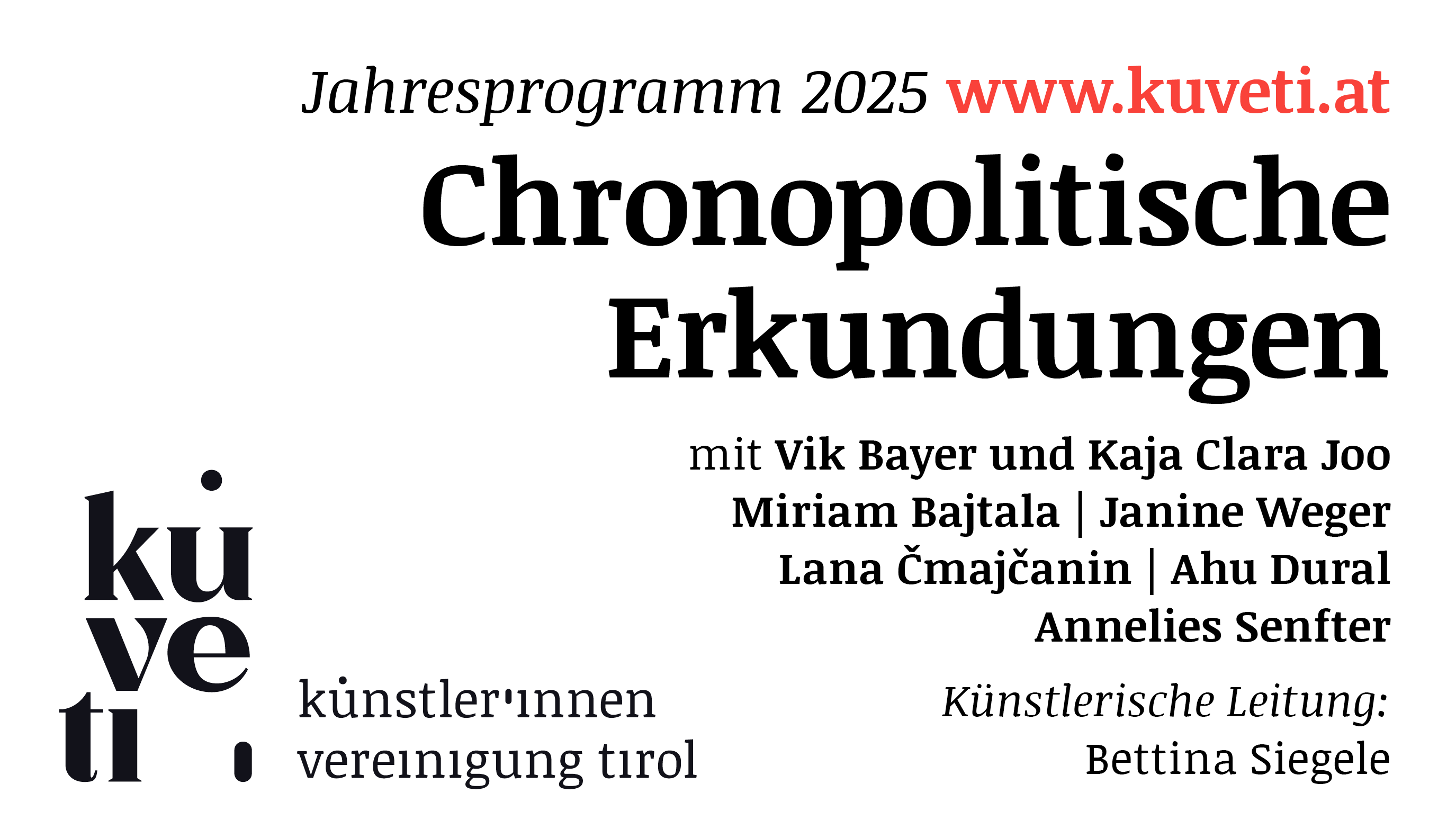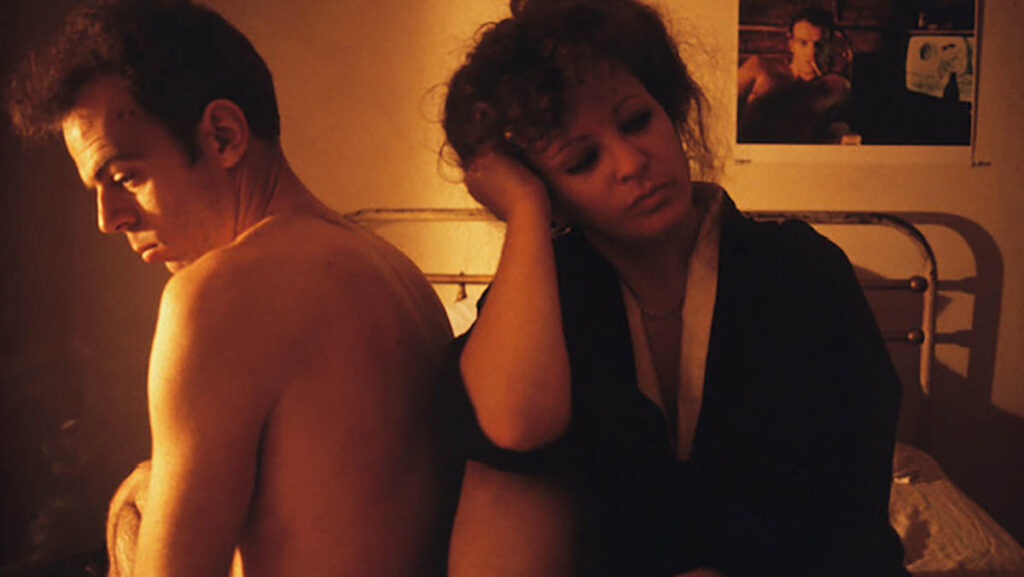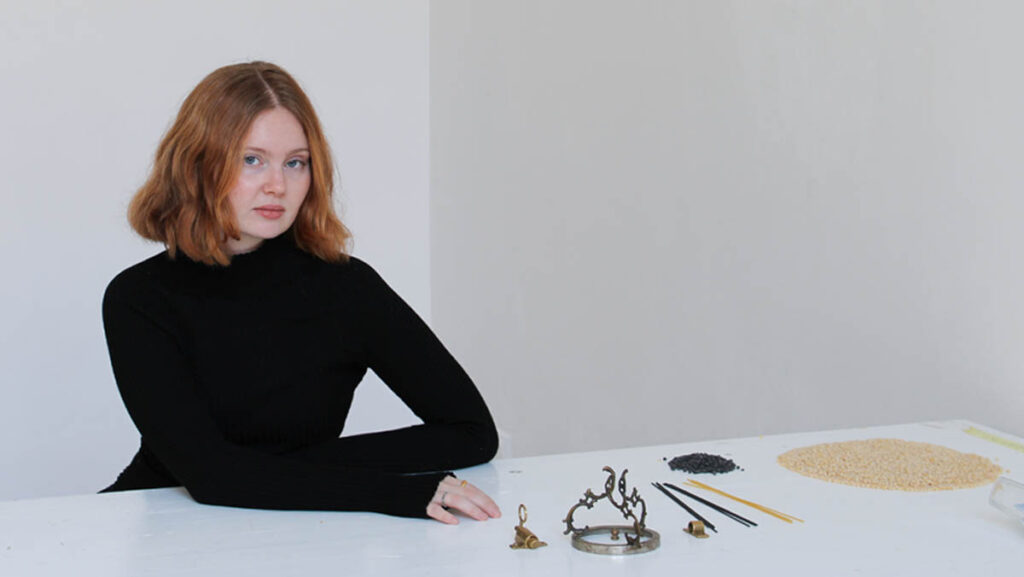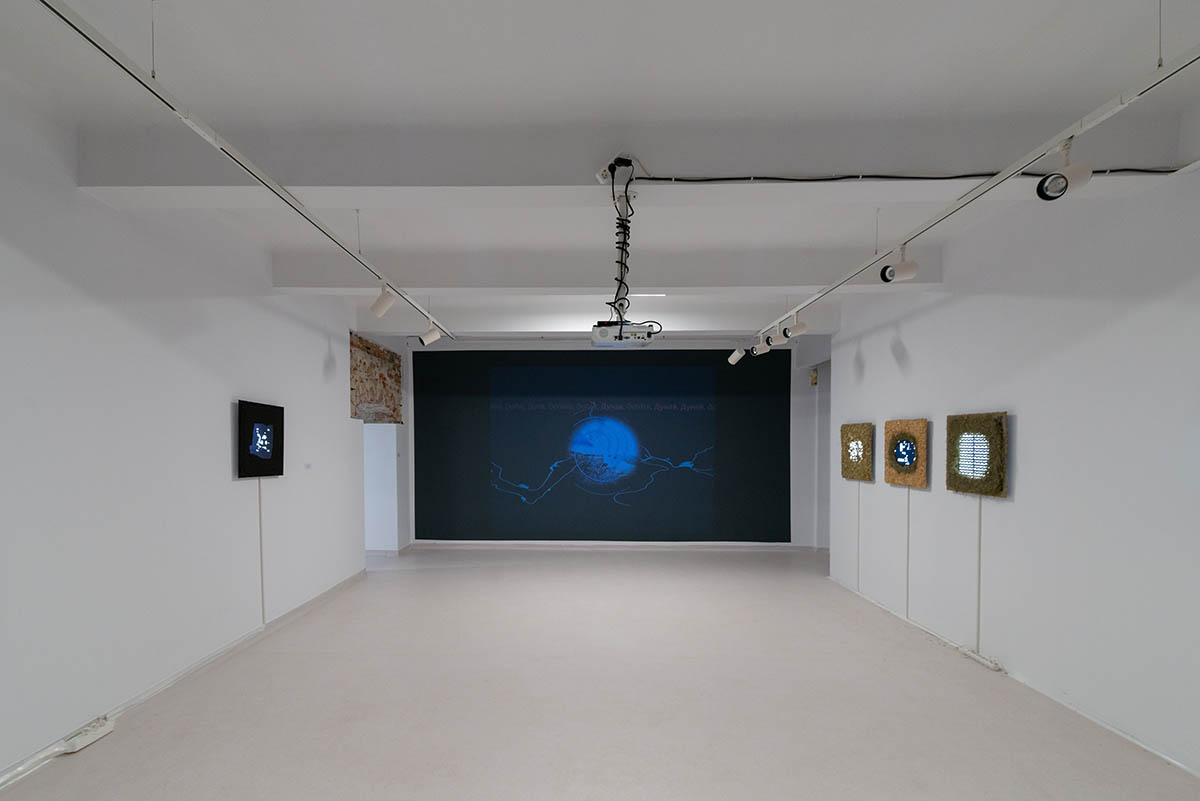
Throughout the project, the Romanian-Norwegian teams have explored themes such as the ecological impact on natural landscapes, the preservation of collective memory, and how water can serve as an artistic metaphor for the connection between people and their environment. Curated by Mirela Stoeac Vlăduți, this exhibition highlights an interdisciplinary collaboration between artists and curators from Romania and Norway. The outcome1 is a project that intertwines artistic research, ecology, and cultural heritage.
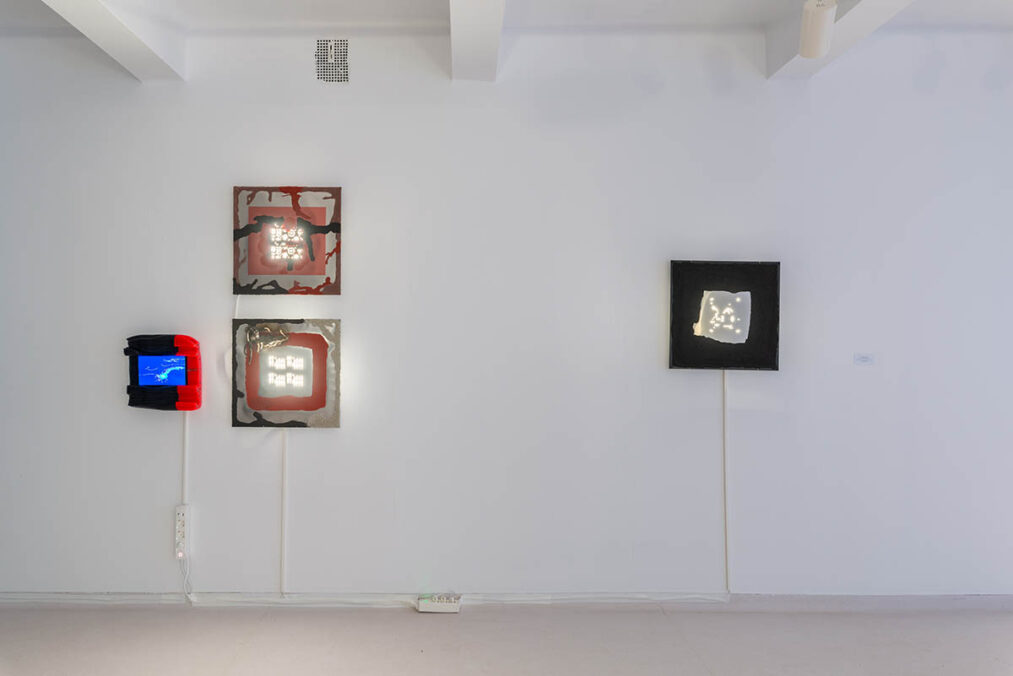
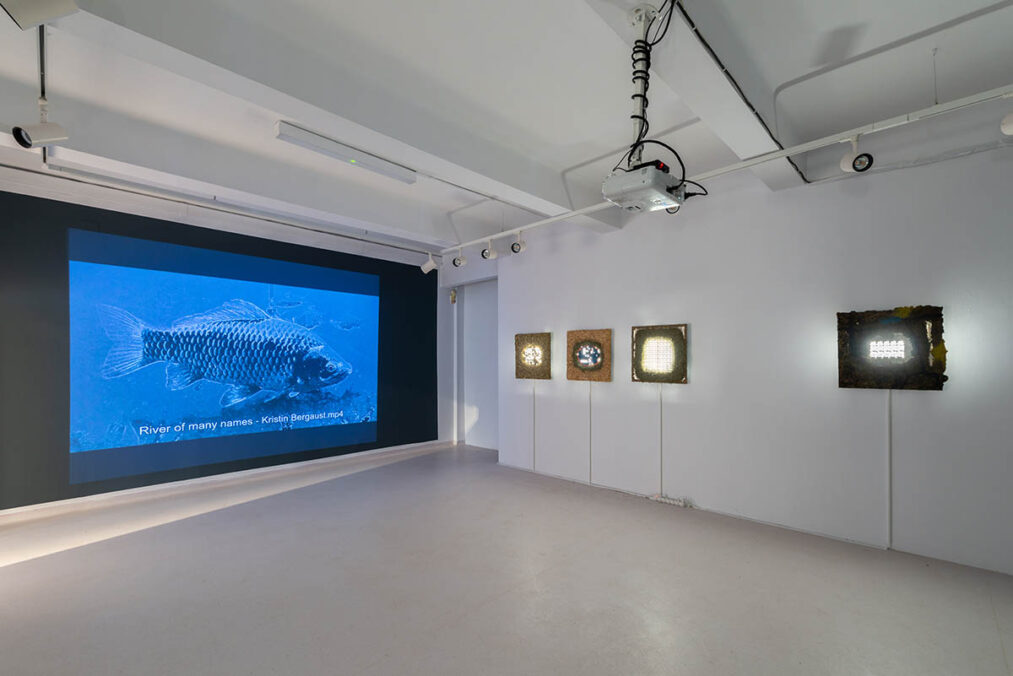
Water is not merely a resource; it is a living entity, a witness, and a storyteller. It carries within its currents the weight of history, the echoes of forgotten voices, and the traces of ecological and cultural transformations. Water, in its ceaseless flow, becomes a metaphor for transformation, a site where past and present dissolve into one another, where narratives are submerged, resurface and are rewritten. The Danube and the Oslo Fjord, two bodies of water separated by geography yet united by their ecological and cultural significance, serve as the anchoring points for this exploration. These rivers are not passive backdrops but active participants in the stories they carry—stories of human endeavor, ecological fragility, and the enduring resilience of nature.
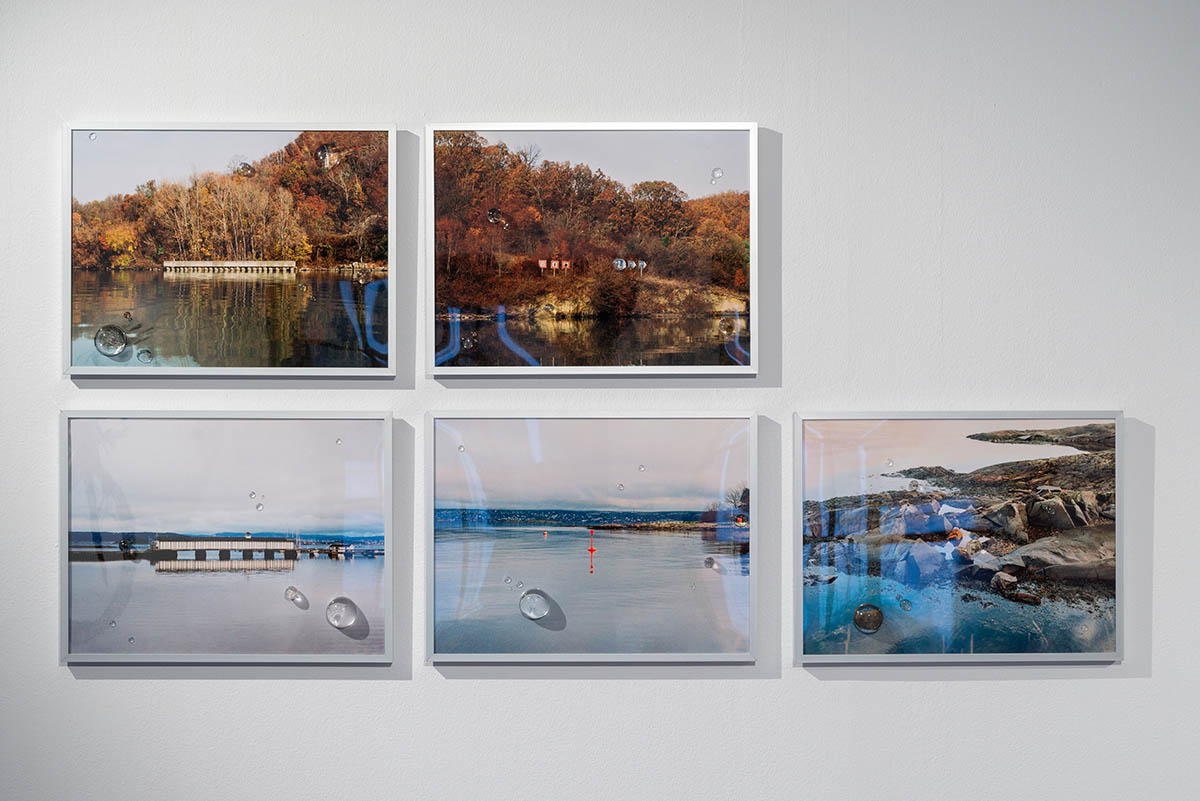
The works presented in the exhibition are not simple reflections on bodies of water; they are explorations on the ways water carries, distorts, and sometimes protects the stories we leave behind. The artists do not approach them as distant, neutral spaces, but as active agents in shaping and reshaping our narratives. The waters themselves are protagonists in these works repositories of cultural memory, fragile ecosystems, and contested sites where ecological, political, and social histories are in constant flux. Water, as the exhibition suggests, is a force that both separates and connects. It can be a source of life, but also an agent of transformation, erasure, and renewal. Through the destabilization of linear narratives, the artists subvert conventional storytelling, embracing instead a fluid state of being that mirrors the paradoxes of water—always in flux, yet holding the power to shape and alter.
Submerged narratives of the Danube and Oslo Fjord. Eco-Cultural tides is a plea to recognize the interconnectedness of all things. It is an invitation to dive beneath the surface, to uncover the truths that lie hidden in the depths of water and time.
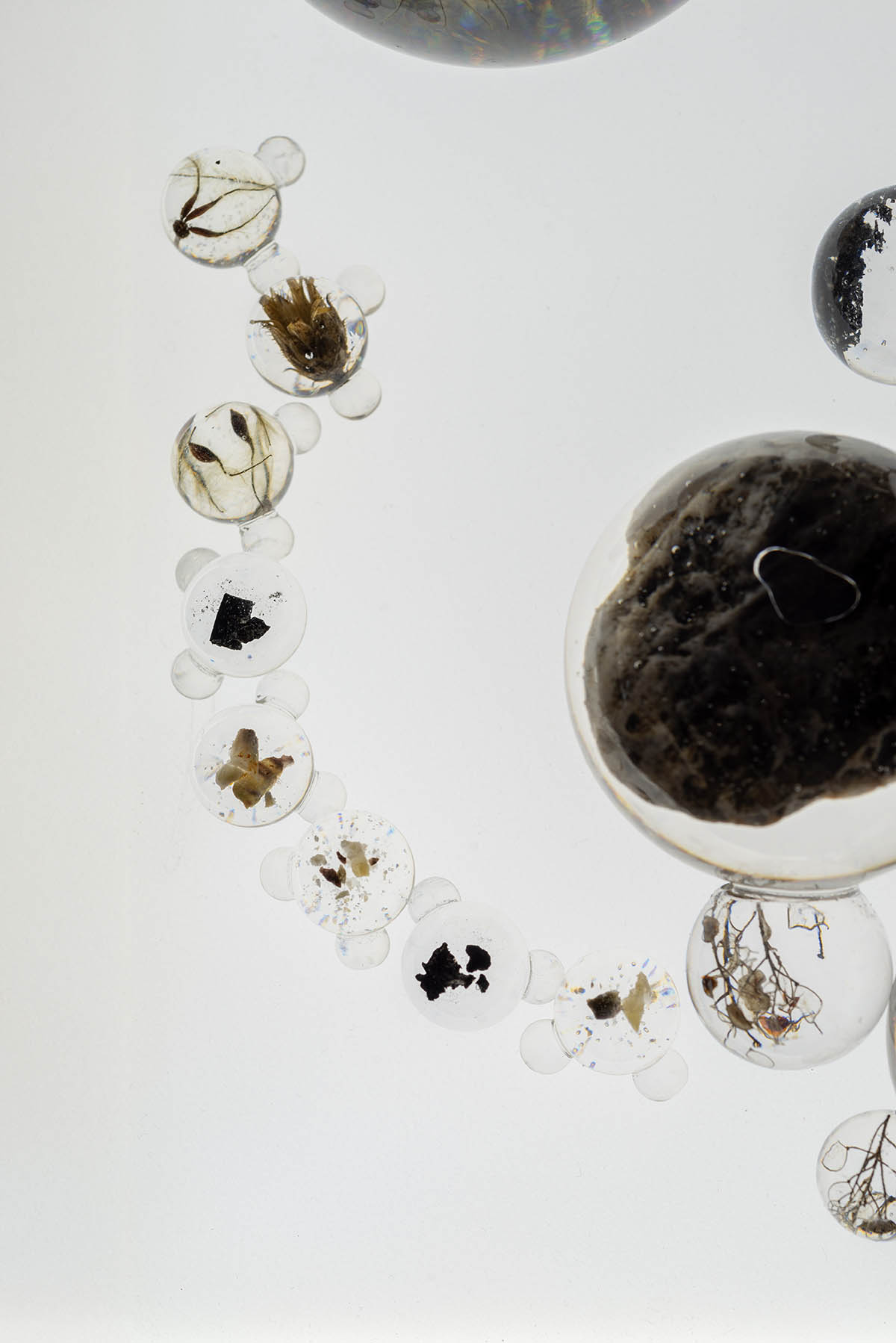
Kristin Bergaust – River of many names
Kristin Bergaust’s video essay River of many names is a poetic and stratified exploration of landscape, memory, and ecological entanglement. Through a synthesis of moving images, archival material, animated sequences, and layered soundscapes, the work examines the river not merely as a geographic entity, but as a living archive of cultural histories, environmental transformations, and shifting human narratives. The artistic practice situates itself at the intersection of art, technology, and research, engaging critically with the relationships between people, environments, and the infrastructures that shape them. In River of many names, the river becomes a conduit for examining historical webs and contemporary ecological urgencies. The title itself evokes the multiplicity of identities ascribed to bodies of water—natural systems imbued with cultural significance, economic utility, and contested territorial histories. Deeply engaged with speculative ecologies and the interplay between nature and technology, the artist constructs a fluid visual and conceptual space that reflects on how waterways shape and are shaped by human intervention. The video essay interrogates how industrialization, urban expansion, and climate change inscribe themselves onto aquatic landscapes, underscoring both their fragility and resilience. The work extends beyond documentation, employing a performative and affective approach to storytelling that challenges anthropocentric perspectives. By weaving together historical references, scientific discourse, and artistic speculation, River of many names not only maps the river’s physical transformations but also amplifies the voices embedded within its currents—voices of forgotten histories, ecological imbalances, and the urgent need for new modes of coexistence. As part of Kristin’s broader artistic inquiry into sustainability, material memory, and the intersections of art and science, the work offers a space for critical reflection.
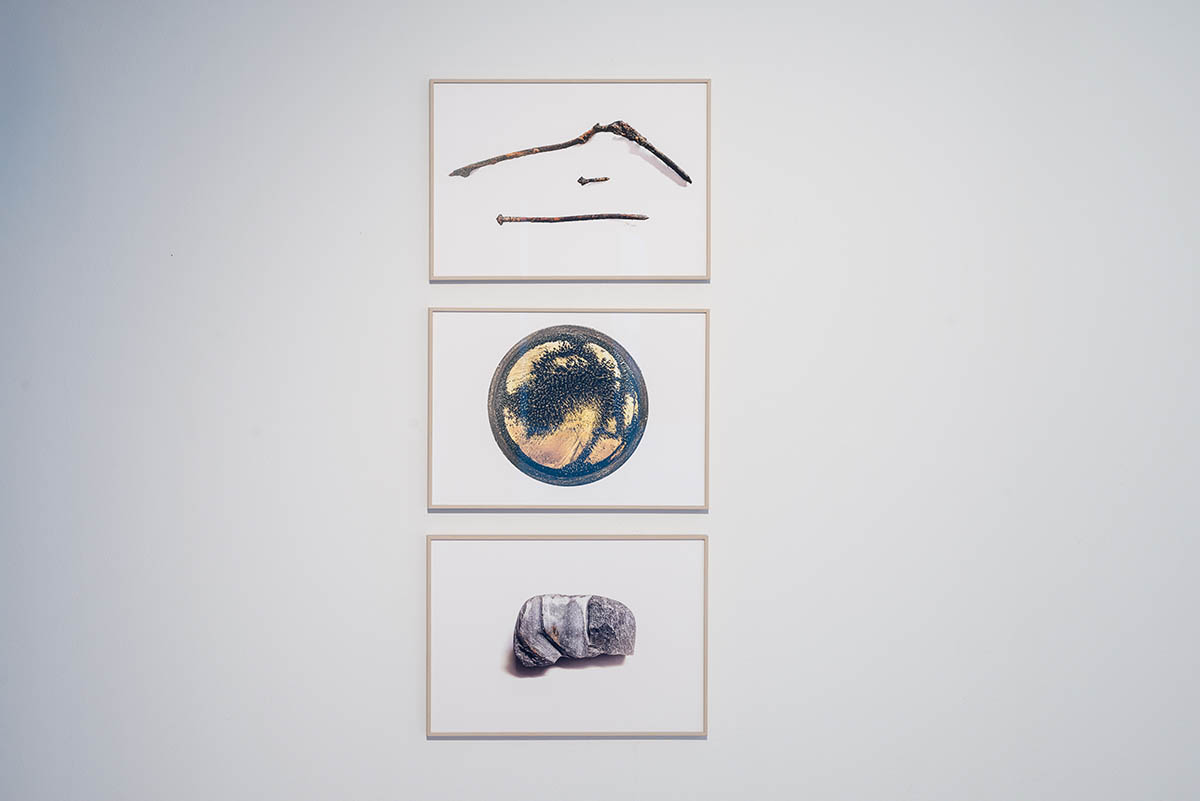
Alex Mirutziu – Dump Cinema
Alex Mirutziu’s film constructs a provocative dialogue between the subterranean erotics of subversive urban life and the fluid irrationality of water. Set against the backdrop of the Danub —understood here not as a definitive site, but as a prelude, a foreplay—Mirutziu’s work operates as an autoreferential extension of his ongoing inquiries into queerness, guilt, and the dialectics of consciousness. The river’s movement becomes both a conceptual and physical metaphor, articulating a tension between release and containment, between the ungraspable and the imposed. Drawing from literary and philosophical references—including the works of Adrienne Rich (“heterosexuality is a violent political institution”) —Mirutziu interrogates consciousness as an unnatural construct, a mechanism that disrupts the organic flow of experience. Through a destabilization of linear thought, the film proposes a radical departure from cognitive fixation, privileging an emptied mind—one that resists the impulse to intellectualize, categorize, or impose structure. In this fluid state of being, awareness itself becomes a form of capital, a currency traded against the embodied immediacy of sensation. Guttural voices punctuate the sonic landscape of the film, evoking a perpetual state of edging—a term borrowed from sexual practice, but repurposed here as a strategy of deferral, a method of keeping the subject suspended, disconnected from full cognitive integration. This perpetual withholding—an overloading of the mind that paradoxically engenders vacancy—mirrors the tension between action and belief, between the imperative to act and the need to justify action through belief. Sometimes in its most visceral, unfiltered forms (see works by Robert Mapplethorpe, Pipilotti Rist, Carolee Schneemann or Sarah Lucas) the artist provokes the viewer to confront repression, subvert dominant ideologies, and expose the intricate ties between desire, control, and social conditioning. Mirutziu’s cinematic language resists resolution, favoring a mode of signification that oscillates at the threshold of comprehension, a complex erotical system in which the viewer (or should we say the voyeur?) is invited into an erotic dialectic of becoming—one that is not bound by consciousness, but rather by the fluidity of its own perception.
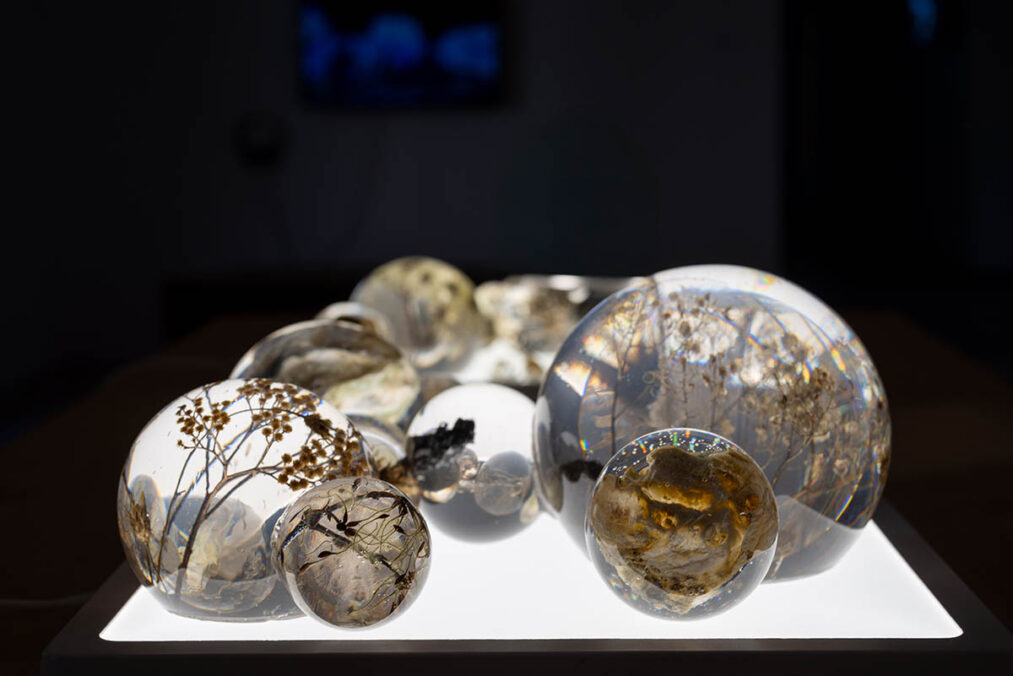
Marina Oprea – Where lucid waters flow
Marina Oprea’s practice engages with processes of accumulation, preservation, and transformation, constructing speculative archives that interrogate identity and memory. In her installation, she combines video, altered film photographs, and sculptural spheres that represent molecular structures, embedding found objects—stones, shells, plants—into epoxy resin. These elements, collected during the residencies in Oslo and at the Danube, function as both material traces of specific locations and conceptual artifacts that reflect on the fluidity of personal and collective histories. The video feels like a dreamy, fragmented reflection on impermanence. The voice in the video flows like a quiet stream, weaving fragments of memory and longing into a whispered tapestry of time, a meditation on the fragile interplay between what is lost and what remains. It drifts, unhurried, through layers of sound, music and silence, carrying with it the weight of forgotten moments and the soft ache of impermanence. Each word feels like a ripple, dissolving as soon as it forms, yet leaving behind an echo that lingers in the mind. It is a voice that does not demand attention but invites reflection, drawing the listener into its current, where past and present merge like watercolors bleeding into one another. It’s all about gestures, textures, and landscapes that seem to dissolve and reform before your eyes. There’s this beautiful tension between things decaying and being preserved, like nature and artifice are in this constant dance. Her film photographs take this idea even further—she physically alters them by embedding bits of material, blurring the line between the image and the object itself. It’s like she’s asking: What’s real? What’s left behind? The artist’s approach resists traditional modes of archiving, instead embracing fluidity and transformation as essential conditions of existence. By preserving ephemeral remnants in synthetic materials, she highlights the paradox of conservation: the very act of safeguarding erases the original state. Her work ultimately questions whether identity can ever be truly fixed, suggesting instead that—like the landscapes she references—is in a constant state of reconfiguration. Through this interplay of organic and artificial, Marina Oprea creates hyperobjects that incorporate both the concept of geological time and a continuous present. Her embedded objects exceed human temporality, existing beyond immediate perception. The act of encasing natural materials in resin mirrors the way geological processes fossilize and transform matter across millennia, suggesting an archive that is neither purely human nor purely natural. In reframing preservation as an open-ended process, she invites us to consider our entanglement with deep time, where objects, memories, and bodies dissolve into one another in an ongoing, inescapable flux. By preserving these fleeting moments in synthetic materials, she points out this weird paradox: the act of saving something often means altering it beyond recognition.
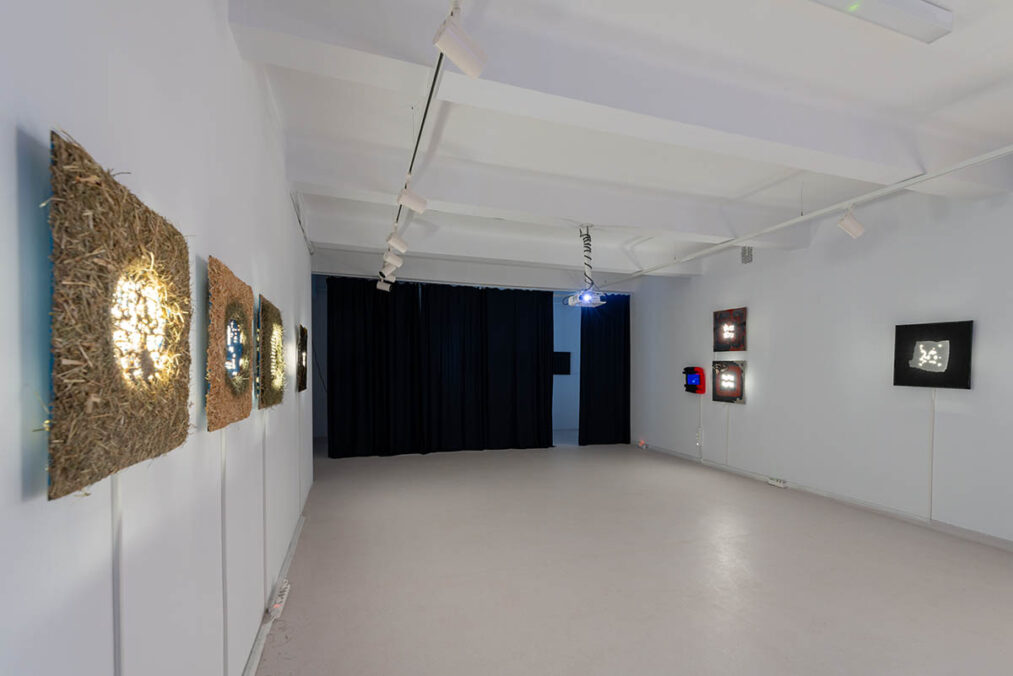
Cosmin Haiaș – Fish & (micro)chips
Fish & (micro)chips is a series of luminescent panels that resemble relics from a distant future. These works encapsulate the geological traces, vegetation, and chromatic essences of both the Danube and the Oslo Fjord, transforming them into artifacts that seem to have emerged from a world where nature and technology have fused into a single, hybrid entity, inviting viewers to contemplate the fluid boundaries between past, present, and future. Haiaș’s artistic practice is defined by a unique fusion of engineering and art, reflecting an interdisciplinary approach. His works are not static objects but dynamic processes, embodying the idea that everything is in flux. In this series, Haiaș addresses recurring themes like: change, innovation, and the tension between permanence and evolution. The panels serve as subtle critiques of the emerging values of advanced technology, while also reflecting deeply on their impact on contemporary society. By embedding geological and botanical elements into synthetic materials, Haiaș creates a dialogue between the natural and the artificial, asking what it means to preserve the essence of a landscape in an era defined by rapid technological transformation. Haiaș envisions a world where art plays a crucial role in humanizing technological progress, encouraging viewers to reflect on the ethical and existential questions raised by these advancements. His work is not merely a critique but a provocation, challenging traditional boundaries of art and inviting us to consider our responsibility in shaping the future, through these portals into a speculative future where the Danube and Oslo Fjord have become sites of both memory and possibility.
Alexis Parra (Pucho) – Fishing report
Through his lens, Alexis Parra (Pucho) invites us to reconsider the stories we tell about the past and the role of water as both a repository of history and a force that reshapes the boundaries of human memory. Far from simply capturing a geographical or historical account, the video is a layered, immersive exploration of the river’s cultural, social, political, ecological, and symbolic significance. The Danube and the Oslo Fjord, two lifelines that stretch across multiple territories and civilizations, hold within their waters the traces of countless human stories, each one shaped by time. Parra’s approach to these narratives is not one of linear storytelling but rather a non linear, fragmented method that mirrors the way water erases, alters, and distorts the past. The concept of „proofs of ways of living“ is central to Parra’s work. These iron objects, corroded by time and water, become evidence of forgotten human narratives—stories of industry, migration, war, and cultural exchange—that have been submerged by the forces of nature. Through his meticulous study of these objects, the artist challenges us to think about the ways in which we remember and forget, how history is preserved or lost, and how water itself can act as a witness to time. Alexis Parra (Pucho) is, in many ways, an archaeologist of water, diving into its depths to uncover fragments of history that speak to the ways we have lived, built, and, at times, failed. These objects, corroded and transformed by their aquatic environments, become metaphors for the fragility of human endeavors and the resilience of nature. His work asks us to consider what traces we will leave behind, and how they will be interpreted by future generations. In this sense, Parra is not just an artist, but a storyteller, a chronicler who uses his practice to bridge the gap between the local and the global, the past and the present. In the end, his art is about connection—between cultures, between humans and nature. It is a practice that challenges us to see the world not as a collection of isolated fragments, but as an interconnected whole, where every action, every object, every story is part of a larger, ever-evolving narrative. And in this narrative, Parra is both a participant and a guide, leading us through the depths of water and time to uncover the truths that lie beneath the surface.
Exhibition: Submerged narratives of the Danube and Oslo Fjord
Exhibition duration: 01.11.2024 – 28.02.2025
Address and Contact:
META Spatiu
1 Bulevardul Mihai Viteazu #1MV
300222 Timișoara, Romania
www.metaspatiu.art
- The project has been developed over multiple phases, including field research and artist residency. It is a cooperation of META Spatiu and SENT Bergaust Norvegia ↩︎



